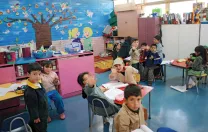The existence of a Harvard Graduate School of Education (HGSE) project in Santiago represents a serendipitous alignment of circumstances. In early 2006, Chile’s newly elected president, Michelle Bachelet—herself a pediatrician—vowed to widen access to preschool, making it free for the poorest 40 percent of the populace. She announced an initial goal of opening 800 new preschool centers in the first year and 3,500 new preschools (with a total of 70,000 slots) in four years. At the same time, the government was becoming interested in how to improve the quality, as well as the quantity, of preschool education, says Steve Reifenberg, director of the Santiago office of Harvard’s David Rockefeller Center for Latin American Studies. The traditional model had by and large been “to take care of kids while their parents are working so they don’t hurt themselves,” says Reifenberg, “rather than something more stimulating.”
Around that time, Chilean businessman Andrónico Luksic Craig was eager to add education to his portfolio of philanthropic activities. He mentioned this desire to Reifenberg, who, in turn, invited a handful of Harvard scholars—HGSE dean Kathleen McCartney and Harvard Medical School’s Brazelton professor of pediatrics Judith Palfrey and associate professor of psychology Catherine Ayoub—to Santiago for a seminar with Luksic and Chilean education officials…and UBC was born.
At the same time, Andrea Rolla, who had experience designing and evaluating early-childhood education initiatives in Costa Rica and El Salvador, had completed her Ed.D. and moved to Santiago. She would become UBC project director. Elisabeth Farrelly, a Yale M.B.A. who had worked for an educational nonprofit in New York and then moved to Santiago with her Chilean husband, was available to become general manager of Luksic’s educational enterprise, Fundación Educacional Oportunidad. And another HGSE graduate, Ernesto Treviño, Ed.D. ’07 (a Mexican national married to a Chilean), completed his degree just in time to direct the evaluation in his new post as a professor of education at Universidad Diego Portales in Santiago.






